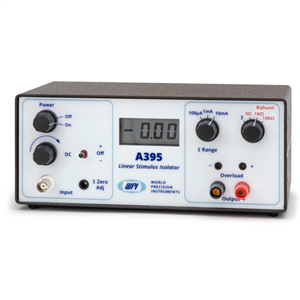

SYS-A395D
Linear Stimulus Isolator
- Overview
- Specifications
- Accessories
- Citations
- Related Products
Overview

There are 1 images available to view - click to enlarge and scroll through the product gallery.
A395 Instruction Manual
/ Download as PDF
- Replicates a programmed waveform of any shape or polarity
- Ideally suited for data acquisition and stimulator generators
- Contains 17 alkaline 9V batteries
- Designed for Neuroscience & Muscle applications
Features
All WPI stimulus isolators are designed to supply constant current because current threshold (not voltage) is the most quantitatively reproducible parameter for stimulation of nerve and muscle. Model A395 dispenses current reproducibly from its Output terminals; the amplitude being determined by the selected current RANGE and the input voltage. Current amplitude is “constant”, that is, load resistance independent, provided that the I x R (load) product does not exceed the available battery supply voltage. A visual indicator (the compliance alarm) will display if I x R reaches this limit. Model A395 D can generate a voltage of 70 volts or more across its OUTPUT terminals. Thus, the user can be sure that the amplitude of the current will be as dialed as long as the voltage drop across the load (stimulus electrode path) does not reach the magnitude of the supply voltage. A visual indicator (the compliance LEDs) displays. The user would then know that (a) too much current was dialed for a given load or (b) inter-electrode resistance was too high or the electrode circuit path was open.
Output current
Model A395 generates an output current of arbitrary (user-defined) wave shape; DC, AC, pulse, and combinations thereof. Battery operated, and photoelectrically-isolated from the input voltage drive, the instrument regenerates output currents which are linearly proportional to the analog voltage waveforms provided by your D/A converter or signal generator. The A395 is ideally suited for data acquisition and stimulator generators. It can be easily daisy-chained for mutiple channel requirements.

Current Delivery
A 10 V input produces the maximum output current for the current range selected. For example, 100µA, 1mA, or 10mA. Front panel controls allow DC current to be generated. Externally applied signals can be superimposed simultaneously (DC offset). Warning lamps indicate open circuit or excessive current conditions.
Digital Meter
Measures DC or average output current.
Overload Lamps
Indicate when output voltage has reached positive or negative compliance voltage limit.
Specifications
| OUTPUT CURRENT, Imax | 3 ranges: 100μA, 1mA, and 10mA |
| OUTPUT VOLTAGE RANGE | ±70V |
| OUTPUT BANDWIDTH | 10 kHz (measured across 1KΩ load R) |
| INPUT RESISTANCE | > 20MΩ |
| INPUT VOLTAGE @ Imax | ±10V |
| INPUT/OUTPUT LINEARITY ERROR | < 0.5% |
| RISE, FALL TIME | 26μs @ 10KΩ |
| POWER:Model A395D | 17 alkaline 9V batteries |
| POWER:Model A395R | 17 rechargeable NiMH 9V batteries |
| DIMENSIONS | 6.5 x 4 x 3.5 in. (16 x 10 x 9 cm) |
| SHIPPING WEIGHT | 4 lb. (1.8 kg) |
Accessories
Citations
Bent, L., Sander, M., Bolton, P., & Macefield, V. (2013). The vestibular system does not modulate fusimotor drive to muscle spindles in contracting leg muscles of seated subjects. Experimental Brain …. Retrieved from https://link.springer.com/article/10.1007/s00221-013-3497-1
Brenneis, C., & Kistner, K. (2013). Phenotyping the function of TRPV1-expressing sensory neurons by targeted axonal silencing. The Journal of …. Retrieved from https://www.jneurosci.org/content/33/1/315.short
Chiang, C., Lin, C., & Ju, M. (2013). On–off control of burst high frequency electrical stimulation to suppress 4-AP induced seizures. Journal of neural engineering. Retrieved from https://iopscience.iop.org/1741-2552/10/3/036017
Moldovan, M., & Pinchenko, V. (2013). Peptide Mimetic of the S100A4 Protein Modulates Peripheral Nerve Regeneration and Attenuates the Progression of Neuropathy in Myelin Protein P0 Null. Molecular …. Retrieved from https://www.ncbi.nlm.nih.gov/pmc/articles/PMC3646097/
Vastani, N., & Seifert, B. (2013a). Sensitivities of rat primary sensory afferent nerves to magnesium: implications for differential nerve blocks. European Journal of …. Retrieved from https://journals.lww.com/ejanaesthesiology/Abstract/2013/01000/Sensitivities_of_rat_primary_sensory_afferent.6.aspx
Vastani, N., & Seifert, B. (2013b). Preconditioning Depolarizing Ramp Currents Enhance the Effect of Sodium Channel Blockers in Primary Sensory Afferents. … : Technology at the …. Retrieved from https://onlinelibrary.wiley.com/doi/10.1111/ner.12031/full




Request
Catalogue
Chat
Print